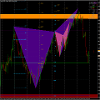Advertisement
Edit Your Comment
Reasonable Drawdown to Monthly Gain
Jun 14, 2013 at 12:06
Miembro desde May 01, 2012
posts 11
Yeah trading with own money. As well as considering of opening a PAMM so I am wondering as an investor what would be a reasonable DD and Monthly %?
There are so many people out there who will tell you that you can’t. What you’ve got to do is turn around and say, ‘watch me’
Jun 14, 2013 at 12:09
Miembro desde Jun 26, 2012
posts 183
for ur own money u shouldnt worry much about dd since u making money... its only a matter of ur trading style.... long term trading means high dd... sometime i pass 50% dd but its ok since i still can make money...
for Pamm n investors... all of them like to see below 20% dd...
for Pamm n investors... all of them like to see below 20% dd...
Jul 26, 2013 at 08:53
Miembro desde Dec 31, 2012
posts 28
I think, there is no standard about this stuff, cause every investor have their own perspective, for example some investor tolerate 50% DD but some only tolerate bellow 5%, but of course low DD% are most smart investor will choose.
if I were investor and I saw signal or money manager that can get profit more than 100% profit permonth,I will invest with them even if DD % are more than 50% but of course I will not invest big money! maybe $100 is more than enough!
cause if their system really works and can get profit more than 100% next year my $100 money will growth 10x times :) i.e 1k usd. if my money growth 10x in a years, maybe I will increase my investment next years 5 times, and so on!
but if I want to invest 10k-100k, definitely I will choose the lowest DD under 5% , cause most of us, can't tolerate DD above 10%! imagine if you invest 100k and seeing 10k floating minus in your account! I bet you cant sleep, eat well at night 😇
if I were investor and I saw signal or money manager that can get profit more than 100% profit permonth,I will invest with them even if DD % are more than 50% but of course I will not invest big money! maybe $100 is more than enough!
cause if their system really works and can get profit more than 100% next year my $100 money will growth 10x times :) i.e 1k usd. if my money growth 10x in a years, maybe I will increase my investment next years 5 times, and so on!
but if I want to invest 10k-100k, definitely I will choose the lowest DD under 5% , cause most of us, can't tolerate DD above 10%! imagine if you invest 100k and seeing 10k floating minus in your account! I bet you cant sleep, eat well at night 😇
Dear all Trader! Good night and sleep well ;)
Miembro desde Apr 07, 2011
posts 69
Jul 28, 2013 at 10:25
Miembro desde Apr 07, 2011
posts 69
The specific strategy and its corresponding track record will be the centre fold of an investors decision and the relevant peak to trough DD / volatility.
If I was aggressive and invested a notional value in relation to my overall cash wealth, then I'd be more happy to incur a larger draw-down. (This is thanks to leverage supplied by liquidity providers.)
On the other hand, if I were a larger investor, and wanted to invest more cash into the given fund/manager, then I may not have the same leverage ratio's available to me because of the sheer size of the deposited funds - i.e. £1m+. In these circumstances, why would you want to take a large draw-down of say 20%, if the standard of living and your own personal gains are not too hard to reach any more, considering you have larger funds invested?
So in a nut-shell, it's really to do with personal goals, relevant to the funds invested, the managers volatility to gains ratio, historical track record and the strategy employed.
£10,000.00 = 35% DD = 90% Annual = £9,000.00 (Tonnes of leverage easily available)
£100,000 = 11.6% DD = 30% Annual = £30,000.00 (Still lots of leverage available - just not as much used.)
£1,000,000.00 = 5% DD = 12.85% Annual = £128,500.00 (Practically no leverage.)
If I was aggressive and invested a notional value in relation to my overall cash wealth, then I'd be more happy to incur a larger draw-down. (This is thanks to leverage supplied by liquidity providers.)
On the other hand, if I were a larger investor, and wanted to invest more cash into the given fund/manager, then I may not have the same leverage ratio's available to me because of the sheer size of the deposited funds - i.e. £1m+. In these circumstances, why would you want to take a large draw-down of say 20%, if the standard of living and your own personal gains are not too hard to reach any more, considering you have larger funds invested?
So in a nut-shell, it's really to do with personal goals, relevant to the funds invested, the managers volatility to gains ratio, historical track record and the strategy employed.
£10,000.00 = 35% DD = 90% Annual = £9,000.00 (Tonnes of leverage easily available)
£100,000 = 11.6% DD = 30% Annual = £30,000.00 (Still lots of leverage available - just not as much used.)
£1,000,000.00 = 5% DD = 12.85% Annual = £128,500.00 (Practically no leverage.)
"Taking responsibility is the cornerstone to a winning attitude"
Miembro desde Apr 07, 2011
posts 69
Jul 28, 2013 at 10:40
Miembro desde Apr 07, 2011
posts 69
The specific strategy and its corresponding track record will be the centre fold of an investors decision and the relevant peak to trough DD / volatility.
If I was aggressive and invested a notional value in relation to my overall cash wealth, then I'd be more happy to incur a larger draw-down. (This is thanks to leverage supplied by liquidity providers.)
On the other hand, if I were a larger investor, and wanted to invest more cash into the given fund/manager, then I may not have the same leverage ratio's available to me because of the sheer size of the deposited funds - i.e. £1m+. In these circumstances, why would you want to take a large draw-down of say 20%, if the standard of living and your own personal gains are not too hard to reach any more, considering you have larger funds invested?
So in a nut-shell, it's really to do with personal goals, relevant to the funds invested, the managers volatility to gains ratio, historical track record and the strategy employed.
£10,000.00 = 35% DD = 90% Annual = £9,000.00 (Tonnes of leverage easily available)
£100,000 = 11.6% DD = 30% Annual = £30,000.00 (Still lots of leverage available - just not as much used.)
£1,000,000.00 = 5% DD = 12.85% Annual = £128,500.00 (Practically no leverage.)
If I was aggressive and invested a notional value in relation to my overall cash wealth, then I'd be more happy to incur a larger draw-down. (This is thanks to leverage supplied by liquidity providers.)
On the other hand, if I were a larger investor, and wanted to invest more cash into the given fund/manager, then I may not have the same leverage ratio's available to me because of the sheer size of the deposited funds - i.e. £1m+. In these circumstances, why would you want to take a large draw-down of say 20%, if the standard of living and your own personal gains are not too hard to reach any more, considering you have larger funds invested?
So in a nut-shell, it's really to do with personal goals, relevant to the funds invested, the managers volatility to gains ratio, historical track record and the strategy employed.
£10,000.00 = 35% DD = 90% Annual = £9,000.00 (Tonnes of leverage easily available)
£100,000 = 11.6% DD = 30% Annual = £30,000.00 (Still lots of leverage available - just not as much used.)
£1,000,000.00 = 5% DD = 12.85% Annual = £128,500.00 (Practically no leverage.)
"Taking responsibility is the cornerstone to a winning attitude"
Jul 28, 2013 at 11:22
Miembro desde Jan 31, 2011
posts 720
It is more important to understand the strategy behind the system.
What has the strategy been tested in?
- Long term, private account? No good for investors.
Long term 99% accurate historical data.....then it depends on the system type.
- Does it use a small stoploss??? No good for investors.
- What types of markets does it deal well with? Tight ranging, wide ranging, whipsawing, moderate trending(<600 pips without major pullback), extreme trending(>600 pips without major pullback), unexpected news breaks, sideways-drifting, trend-drifting. Really, the only market-type that is incompatible with the group is extreme trending. From what i have seen, If a system works well in extreme trending, it struggles in the rest, and vice-versa. Add to that, extreme trending does not occur very frequently, and when it does, it is basically impossible to predict until a system is already locked into some major DD. At that point, the question is always, how far will this market run before it consolidates, and after consolidation...will it continue?
I would say this is a general guideline for systems and the target investors who would be interested in using them.
#1- small investors want massive gains (> 20%/month), and they are willing to deal with huge DD for immense gain.
#2-medium investors want a reasonable gain (>5%/month), and they want no DD.
#3-large investors want a guaranteed gain (amount doesn't matter), and they understand that a system sometimes requires open DD, but they want to KNOW, in the end they will be gaining equity.
What has the strategy been tested in?
- Long term, private account? No good for investors.
Long term 99% accurate historical data.....then it depends on the system type.
- Does it use a small stoploss??? No good for investors.
- What types of markets does it deal well with? Tight ranging, wide ranging, whipsawing, moderate trending(<600 pips without major pullback), extreme trending(>600 pips without major pullback), unexpected news breaks, sideways-drifting, trend-drifting. Really, the only market-type that is incompatible with the group is extreme trending. From what i have seen, If a system works well in extreme trending, it struggles in the rest, and vice-versa. Add to that, extreme trending does not occur very frequently, and when it does, it is basically impossible to predict until a system is already locked into some major DD. At that point, the question is always, how far will this market run before it consolidates, and after consolidation...will it continue?
I would say this is a general guideline for systems and the target investors who would be interested in using them.
#1- small investors want massive gains (> 20%/month), and they are willing to deal with huge DD for immense gain.
#2-medium investors want a reasonable gain (>5%/month), and they want no DD.
#3-large investors want a guaranteed gain (amount doesn't matter), and they understand that a system sometimes requires open DD, but they want to KNOW, in the end they will be gaining equity.
Make losses, but always come out a winner at the end.
Aug 02, 2013 at 09:15
Miembro desde May 16, 2012
posts 50
Responding to your comment on draw downs! If you do your research and practice on demo accounts, you should never have a draw down on your account. I have traded for 7 years and I might not make very much money for a month or so, but I always show an increase at the end of the month. If you like trading behind the 8 ball, you will not get very far in this business. Learn to control yourself, and then you will succeed!
Only take what the market will let you have, and Never accept a loss!
Aug 05, 2013 at 21:57
(editado Aug 05, 2013 at 21:57)
Miembro desde Mar 20, 2010
posts 52
Scott, it is absurd to imply that one should never have a DD on your account. All traders and systems have DD -- and it does not have to occur at the month end, it can occur intermonth. Moreover, 7 years trading without one negative month is such an extreme statement that needs backup, like a direction stats connection to your MT4 account. Otherwise it is BS.
“Ah, but a man's reach should exceed his grasp, or what's a heaven for?” Robert Browning
Aug 06, 2013 at 07:08
Miembro desde May 16, 2012
posts 50
I will be honest with you, inside a month I could have a draw down because of human error, or a trend that decides to change or I decide to get out of a recent trade because of a gut feeling. But at the end of every month, for the last almost 4 years, I have not had one month that has shown a DD. Several years back I did have my rules that went bad and yes I did have a loss here and there, but I had a friend notice why I would have an occasional loss and he helped me re-write my rules and now we just do not trade in these areas, and it must have helped, because no more Month end loss. I went back and researched and I have not had a DD week this year yet, and I can not say what the future will give me. I can tell you that I will have another loss some day, it is just inevitable that it will happen in the game we play!
Only take what the market will let you have, and Never accept a loss!
Miembro desde Apr 07, 2011
posts 69
Aug 07, 2013 at 09:16
Miembro desde Apr 07, 2011
posts 69
sbresee posted:
I will be honest with you, inside a month I could have a draw down because of human error, or a trend that decides to change or I decide to get out of a recent trade because of a gut feeling. But at the end of every month, for the last almost 4 years, I have not had one month that has shown a DD. Several years back I did have my rules that went bad and yes I did have a loss here and there, but I had a friend notice why I would have an occasional loss and he helped me re-write my rules and now we just do not trade in these areas, and it must have helped, because no more Month end loss. I went back and researched and I have not had a DD week this year yet, and I can not say what the future will give me. I can tell you that I will have another loss some day, it is just inevitable that it will happen in the game we play!
(facepalm) - I don't think you understand how the word draw-down applies to various contexts within trading. Your martingale time bomb system you have hooked up has sat through a disgusting 55+% draw-down... That is drawdown, despite what your month ending balance is...
And to be honest, it's the most horrific system you could have bought too... Don't write back to me with a hostile attitude, I am telling you, that is a matter of time before it blows up, irrelevant of what the month ending balance is.
"Taking responsibility is the cornerstone to a winning attitude"
Aug 07, 2013 at 10:55
Miembro desde Jan 31, 2011
posts 720
Normally, I would agree that any grid or martingale system will eventually die. That said, it all depends on whether or not it has been calculated to deal with mega-trends. If the balance is large enough, and the lot size small enough, it could survive. But, a person must keep in mind, not many accounts can survive a 2000 pip run, let alone a 12000 pip run....and both do happen.
Historically speaking the system has been performing reasonably (~10% max DD), until recent history. The problem is, what type of exit strategy is there if the system continues to accumulate DD?? I have watched as friends of mine have wiped out $400k accounts with these type of systems. When I say wiped-out, I mean $400k down to $20k. The type of losses that make a person physically ill.
I guess what I am trying to say is, if you don't have an exit strategy all lined up, now is a great time to start figuring one out.
Historically speaking the system has been performing reasonably (~10% max DD), until recent history. The problem is, what type of exit strategy is there if the system continues to accumulate DD?? I have watched as friends of mine have wiped out $400k accounts with these type of systems. When I say wiped-out, I mean $400k down to $20k. The type of losses that make a person physically ill.
I guess what I am trying to say is, if you don't have an exit strategy all lined up, now is a great time to start figuring one out.
Make losses, but always come out a winner at the end.
Miembro desde Apr 07, 2011
posts 69
Sep 06, 2013 at 13:33
Miembro desde Apr 07, 2011
posts 69
Mirko42 posted:
It is all depends of your strategy. Like if you're Martingale lover, you might let your DD go almost to the point of margin call.
That is not a strategy :s? Lol!
"Taking responsibility is the cornerstone to a winning attitude"
Sep 07, 2013 at 00:55
Miembro desde Oct 26, 2009
posts 49
domgilberto1 posted:Mirko42 posted:
It is all depends of your strategy. Like if you're Martingale lover, you might let your DD go almost to the point of margin call.
That is not a strategy :s? Lol!
Yes it is... and here you have a perfect example for that... ofc you dont let it reach the point of margin call and the lesser the DD then the better is the system...
Take a look at http://www.myfxbook.com/members/bfe00325/forexfarmer-whiterock-fx-3000/665133
You can find my facebook page at https://www.facebook.com/forexfarmer
Cheers
Pedro
Miembro desde Apr 07, 2011
posts 69
Sep 09, 2013 at 09:21
Miembro desde Apr 07, 2011
posts 69
bfe00325 posted:domgilberto1 posted:Mirko42 posted:
It is all depends of your strategy. Like if you're Martingale lover, you might let your DD go almost to the point of margin call.
That is not a strategy :s? Lol!
Yes it is... and here you have a perfect example for that... ofc you dont let it reach the point of margin call and the lesser the DD then the better is the system...
Take a look at http://www.myfxbook.com/members/bfe00325/forexfarmer-whiterock-fx-3000/665133
You can find my facebook page at https://www.facebook.com/forexfarmer
Cheers
Pedro
"Taking responsibility is the cornerstone to a winning attitude"

*El uso comercial y el spam no serán tolerados y pueden resultar en el cierre de la cuenta.
Consejo: Al publicar una imagen o una URL de YouTube, ésta se integrará automáticamente en su mensaje!
Consejo: Escriba el signo @ para completar automáticamente un nombre de usuario que participa en esta discusión.


















